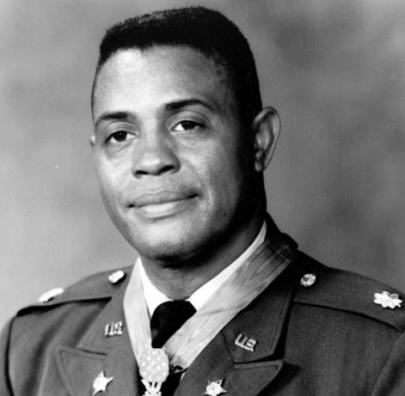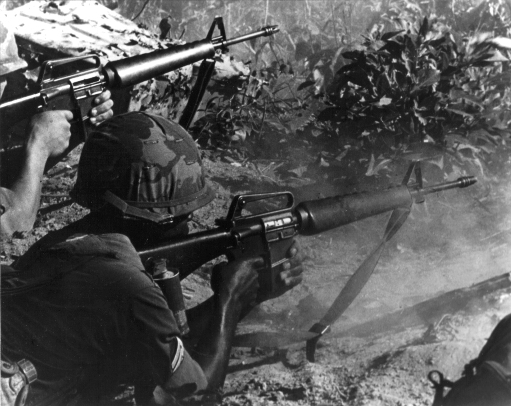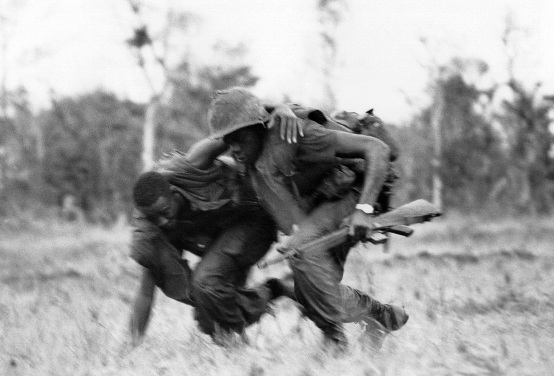
Good Morning POU!
Today’s Medal of Honor hero was also an honoree as “Badass of the Week” for his bravery in Vietnam.
Charles C. Rogers
Charles Rogers joined the U.S. Army through the Army ROTC program at West Virginia State College (now West Virginia State University), in 1952, and by 1968 was serving as a Lieutenant Colonel in command of 1st Battalion, 5th Field Artillery Regiment, 1st Infantry Division in Vietnam.
Via Badass of the Week:
Charles Calvin Rogers was a math major. A Lieutenant Colonel. An artillery commander. A decorated senior officer whose job involved staying back behind the front lines calculating firing angles with a slide rule and a portable astrolabe, launching artillery shells the size of small children at enemy coordinates screamed into his ear via radio by panicking junior-grade infantry officers, and blowing the crap out of things at such long distances he needed a decent hill and a pair of high-magnification binoculars just to get a decent look at the fireworks.
He wasn’t supposed to be bayonet-charging a horde of North Vietnamese Army regulars on the Cambodian border in the middle of Halloween night with two goddamned chunks of burning-hot mortar shrapnel embedded in his ribs and AK-47 bullets ripping up the jungle underbrush around from every direction.
But when the opportunity presented itself, he didn’t pass it up. He rallied his troops, slapped a magazine into his rifle, and didn’t stop cracking skulls until the sun came up.
Midnight had just ticked Halloween 1968 over to November 1 when the first NVA mortar bursts began raining high-explosive shrieking death down onto Fire Base Rita, a forward position deep in the jungles on the Vietnam-Cambodia border. Red flares went up in the woods, backlighting a sea of movement that was punctuated by battle cries, death screams, and a non-stop stream of full-auto machine gun fire that lit up the night with enough tracer fire to make the once-peaceful rain forest immediately start looking like a laser gun firefight from the old-school 1980s G.I. Joe cartoons.
It was a full-on NVA human wave attack. Hundreds of battle-hardened, tough-as-nails Vietnamese infantry poured out of the jungle, laying down covering fire with mortars, grenades, RPGs and machine guns, barreling down on a vastly-outnumbered U.S. position that suddenly found itself in a desperate struggle between life and a grisly death.
Lieutenant-Colonel Charles Calvin Rogers, commanding officer of the 1st battalion, 1st Infantry Division, rushed outside his tent, took immediate stock of the situation while RPG contrails streamed overhead, and went right to work positioning his howitzer batteries to blanket the jungle with great vengeance and furious anger.
Rogers’ guns sprung to life, barfing anti-personnel shrapnel-filled fireballs straight into the face of the onrushing enemy horde, exploding asses and balls and other unspeakable things in a cloud of dust, but still the fearless Vietnamese warriors rushed onward, undaunted by the destruction in their ranks. Balls-out NVA combat engineers, racing frantically under the cover of mortars and suppressing fire, ran right up to the American barricade, undauntedly planted explosive charges while U.S. infantry fired point-blank into their ranks, and then blasted huge gaping holes through the firebase’s outer walls. Through the cloud of dust, dirt, and blown-apart sandbags rushed a seemingly-endless stream of screaming fighters armed with bayonets and AK47s.
Calvin Rogers, a 16-year veteran from West Virginia, hadn’t seen the enemy this close in a long time. Steel-eyed and resolute in his need to kick asses and save his men, the 39 year-old Lieutenant Colonel grabbed his helmet and rifle and raced right up towards the front-line artillery positions – nothing was going to keep his guns from firing, and he was absolutely determined to turn back this assault before the enemy swept in and overran his artillery position.
Rushing straight into the teeth of the attack, Colonel Rogers barked orders at his shell-shocked men, most of whom had never been quite so close to an enemy mortar attack before. Grabbing men by their jackets and pulling them to their feet, Rogers seemed to utterly ignore the tracer bullets and epic action-movie grade explosions rocking the jungle around him as he personally turned the guns into position, rallied his men, and shouted out firing coordinates and directions. When one enemy mortar shell airbusted right above his damn head, the concussive blast knocking him off his feet and into the dirt below, Rogers didn’t even seem concerned – he popped right back up on his feet, and the burning shrapnel in his body didn’t even seem to stop him from completing the sentence he’d started right before being blown the hell up.
Almost immediately after this, a call came up from another battery – the NVA were crawling up their asses, swarming over the sandbagged defenses, and the artillery positions were in danger of being overrun and flanked.
Rogers, a battalion commander who was already bleeding and wounded, organized a small crew of U.S. artillerymen, told them to grab their rifles, and personally led a counterattack straight into the face of a much-larger enemy force. After an intense midnight firefight and the utter confusion hand-to-hand combat where Rogers personally killed a few of the enemy but also took a bullet from an AK-47, his determined attack threw them back and recaptured the gun.
During the subsequent break in the fighting medics raced over to Rogers, who by now was covered in blood (both his and that of his enemies), but he refused medical treatment – he was in full-on blood rage berserker mode and a stupid little thing like a couple profusely bleeding bullet and shrapnel wounds weren’t going to keep him from single-handedly saving the 1st Artillery Battalion, 1st Infantry Division — the oldest artillery unit in American history (originally formed by Fat Henry Knox) – from complete annihilation.
He knew the fight wasn’t over. And he was right.
After a brief break to regroup, the NVA tried a second assault, this time at a different part of the American line. Rogers, rallying his exhausted, bloodied, wounded troops, once again directed a metal storm of artillery shells raining down on the attackers like a piñata from hell or one of those Ice Storm wizards from Warcraft II. When they got too close for comfort, Rogers regrouped his ad hoc strike team, hurled them into the breaches, and again personally shot up the enemy bad enough that they were forced back to the jungle to regroup.
By this point dawn was breaking over the jungle. The Vietnamese had one final chance to launch their attack before the sun would deprive them of the cover of darkness. This time, they pulled out all the stops, hurling the last reserves of their exhausted soldiers straight-on into the teeth of the American defenses in a last desperate attempt to crush Firebase Rita to rubble, capture the U.S. artillery pieces that had wrought so much horror on their lines, and turn them against their former owners.
Charles C. Rogers had other ideas. Already twice wounded, and having led two separate counterattacks, he again rallied his men for action. He checked their health, got them resupplied, and personally went up and down the line encouraging them to fight their asses off and hold their positions at all costs.
This attack was the most brutal. The NVA, charging ahead under mortars and rocket-propelled grenades, filled the jungle with explosions and shrapnel in a desperate final attack. Lt. Col. Rogers stood tall, again directing his troops, but when a Vietnamese mortar shell detonated over one of his howitzers, killing most of the gun crew, this ferocious one-man army sprung into action, personally racing over and manning the gun almost by himself.
Rogers point-blank blasted the enemy at zero elevation, rocking fire straight into the hard-charging enemy forces. Another heavy mortar round blasted his artillery piece, blowing the thing up in his face, knocking him from his feet, and racking his body with twisted metal shrapnel. Unable to stand, and bleeding badly, he continued to shout directions and orders to his men, encouraging them to fight on, directing fire even as medics were tending to his wounds.
The line held.
By the time Richard Nixon awarded Charles Calvin Rogers the Medal of Honor in 1970, Rogers had already been back in ‘Nam for a year. He would serve through the rest of the war, then be transferred to Germany, where he was promoted to Major General, given command of NATO’s VII Corps Artillery in Berlin, and spent the late 70s and early 80s preparing plans to counter a possible Soviet attack against West Germany. When that didn’t look like it would actually ever happen he retired in 1984, got an M.A., and became a Baptist minister.
He remains the highest ranking Black American to ever receive the Medal of Honor.




